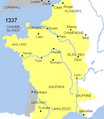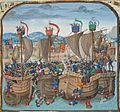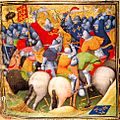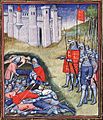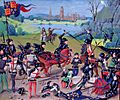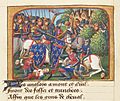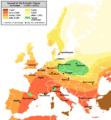Hundred Years' War facts for kids
Quick facts for kids Hundred Years' War |
|||||||||
|---|---|---|---|---|---|---|---|---|---|
| Part of the Anglo-French Wars | |||||||||
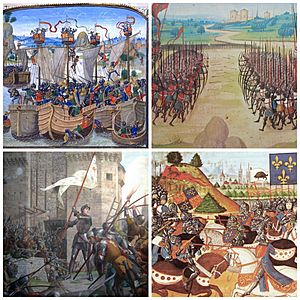 Clockwise, from top left: The Battle of La Rochelle, The Battle of Agincourt, The Battle of Patay, Joan of Arc at the Siege of Orléans |
|||||||||
|
|||||||||
| Belligerents | |||||||||
|
|
||||||||
| Commanders and leaders | |||||||||
|
|
||||||||
The Hundred Years' War was fought between France and England during the late Middle Ages. It lasted 116 years from 1337 to 1453. The war started because Charles IV of France died in 1328 without an immediate male heir (i.e., a son or younger brother). Edward III of England then believed he had the right to become the new king of France through his mother.
The French did not want a foreign king, so Philip VI of France said he ought to be king because by the Salic law women could not rule or transmit the right to rule to their sons. The two countries went to war because of this disagreement.
At the beginning of the war France was the stronger of the two countries as it was wealthier, more populous while French knights and heavy cavalry also enjoyed a great military reputation in all of Christendom. France had about 17 million people while England had only about 4 million people. France was however a decentralised feudal monarchy in the middle ages, so was not as unified. France had an alliance with Scotland and Bohemia, while England was supported by parts of the Low Countries and by some regions in France loyal to the Plantagenet kings of England. The English won a major victory at sea in the Battle of Sluys in 1340 which prevented France from invading England. After that most of the war was fought in France. England then won an overwhelming victory at the Battle of Crécy in 1346 against all odds: the use of the English longbow and stakes to counter the French cavalry played a decisive role in the victory.
From 1348 to 1356 there was very little fighting because of the Black Death which killed many people in England and even many more people in France. Then Edward, the Black Prince won another brillant victory at the Battle of Poitiers for England. King John II of France was captured during the battle. The English invaded France again but were not able to take any more cities. A truce in 1360 gave England about one quarter of France. This first part of the Hundred Years' War is called the Edwardian War.
The war started again in 1369. The new king Charles V of France was more successful, with Bertrand du Guesclin as his best knight. France allied itself with Castile against England and Portugal and some of the fighting spilled into Spain and Portugal. France won back most of the land previously given to the English during this time and Bertrand du Guesclin won great victories at the battles of Cocherel and Pontvallain for France. A peace followed from 1389 to 1415. This second part of the war is called the Caroline War.
The most famous part of the war began in 1415. Henry the V of England invaded France and won the infamous Battle of Agincourt again thanks to his great longbowmen. A sizeable part of the French nobility is said to have been killed in that battle. King Charles VI of France was insane and unable to rule, and nearly all his sons died young. The queen of France, Isabeau of Bavaria, married one of her daughters to Henry V and signed the Treaty of Troyes to make Henry V the next king of France. Both Henry V and Charles VI died around the same time in 1422. So the English believed his son Henry VI of England was now the rightful king of France and many French people agreed. Charles VI's last son Charles VII of France said he ought to be the new king, but many French people said he did not deserve to be king because somebody else had probably been his father.
The English continued to capture land in France and formed an alliance with Burgundy. They won another major victory at the Battle of Verneuil. But in 1429, Joan of Arc led the French army to success at the Siege of Orleans. Then at the Battle of Patay that same year, French knights led by La Hire won a great victory and the French heavy cavalry killed most of the veteran English longbowmen. Joan regained many cities in the north-east of France and brought Charles VII to his coronation, but she did not recover Paris. She was captured by the Burgundians in 1430, convicted of heresy and burned at the stake in 1431. After her death, the French continued to take back their territory piece by piece. France had a diplomatic win in 1435 with the Treaty of Arras where Burgundy stopped being England's ally and made peace with France. In 1450, France won another great victory at the Battle of Formigny and reconquered Normandy. The war ended in 1453 with a crushing victory of the French at the Battle of Castillon where nearly 300 cannons made by Jean Bureau and his brother Gaspard were used for the first time in a battle. This third and last part of the war is called the Lancastrian War.
Images for kids
-
Homage of Edward I of England (kneeling) to Philip IV of France (seated), 1286. As Duke of Aquitaine, Edward was also a vassal to the French King (illumination by Jean Fouquet from the Grandes Chroniques de France in the Bibliothèque Nationale de France, Paris).
-
Battle of Sluys from a BNF manuscript of Froissart's Chronicles, Bruges, c. 1470.
-
Battle of Crécy, 1346, from the Grandes Chroniques de France. British Library, London
-
Edward III counting the dead on the battlefield of Crécy
-
Black Monday (1360), hailstorms and lightning ravage the English army at Chartres
-
Statue of Bertrand du Guesclin in Dinan
-
Fifteenth-century miniature depicting the Battle of Agincourt of 1415
-
The first Western image of a battle with cannon: the Siege of Orléans in 1429. From Les Vigiles de Charles VII, Bibliothèque nationale de France, Paris.
-
Joan of Arc (picture 1429)
-
The Battle of Formigny (1450)
-
Charles "the Victorious" by Jean Fouquet. Louvre, Paris.
-
The spread of the Black Death (with modern borders)
See also
 In Spanish: Guerra de los Cien Años para niños
In Spanish: Guerra de los Cien Años para niños



